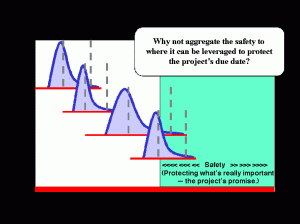We learned in class how Critical Path Method (CPM) can assist us in delivering a project on time and in a successful manner. There is, however, a dark side to such an approach in managing a project. This dark side is of fault of CPM, but rather it is caused by phenomena best described as the Parkinson’s Law and Murphy’s Law. In a nutshell Parkinson’s Law states that work will fill, and often exceed, the time allowed. Murphy’s Law tells us that whatever can go wrong will go wrong.
PARKINSON AND MURPHY
Let me provide an example to illustrate the correlation between the dark side of CPM and these two laws. I have a research paper to do and it is due in 3 weeks. It will take me 2 weeks to turn it into an “A” paper. Since I have 1 week of slack time I decided to start my project on week 2. This delay in starting, as suggested by Parkinson’s Law, is a natural postponement that results in the entire project time being used. The dark side also has another weapon to derail my project – uncertainty.
Murphy’s wisdom tells us that when something can go wrong, it will. The uncertainly I may face can be trouble with research materials, my computer stops working, my car breaks down, I get sick, etc. These are just some uncertainties that can cause me to miss my deadline. My only recourse in such an event is to crash the project. The cost of crashing will most likely be a less quality paper.
LET’S GET BUFF
The Critical Chain Scheduling and Buffer Management approach is one way to combat this dark side of CPM. Basically, this approach assigns each task time based on an aggressive estimate, which has a 50% confidence level of completion, and the safety time of each task is allocated into a buffer location. When a task is completed in excess of the assigned time, which will most likely be the case because of the 50% confidence level of completion and the time spend on dealing with uncertainty, an equal amount of time will be deducted from the buffer. By monitoring the buffer I can assess the status of my project and take action when the buffer reaches a critical level.
The use of Critical Chain Scheduling and Buffer Management can counter the effects of Parkinson’s Law and Murphy’s Law. This, however, does not render CPM ineffective, nor does it diminish its usefulness. What I’m trying to do here is to provide a bit more holistic view on CPM. In addition, my description of Critical Chain Scheduling and Buffer Management is by no means comprehensive; a more detail description on this topic can found at http://www.focusedperformance.com/articles/ccpm.html. By understanding the characteristics of CPM we can better plan our project and combat against postponement and uncertainty.
REFERENCE
Francis, P. (1999, April). Critical Chain Scheduling and Buffer Management: Getting Out From Between Parkinson’s Rock and Murphy’s Hard Place. Retrieved from Focused Performance: http://www.focusedperformance.com/articles/ccpm.html

